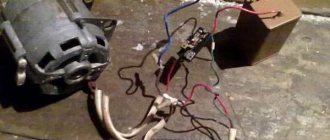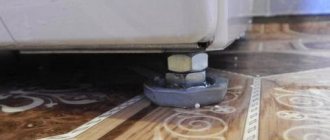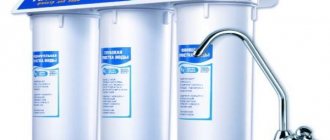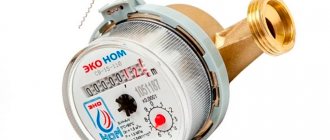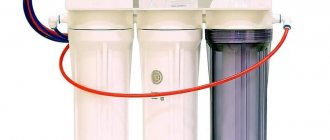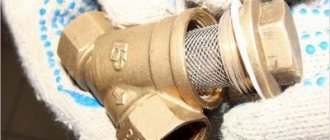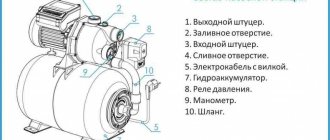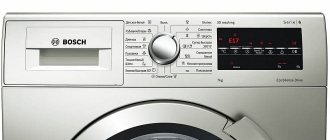Hard water with rust or dirt is the main enemy of modern household appliances.
More than half of all heating element breakdowns are caused by bad water, so special filters are used to protect washing machines and other expensive equipment.
Most machines have a pre-installed coarse filter that traps hair, threads, buttons and other large debris, but it is not able to cope with small particles.
That is why it is recommended to install an additional filter for the washing machine in case of bad rusty water.
First of all, it will help eliminate mechanical impurities that clog the internal filter, which reduce the pressure and ultimately lead to the machine stopping taking in water.
Water with rust and sand significantly reduces the service life of the water drain pump. In addition, the quality of washing noticeably deteriorates, because the dirtier the water, the worse the washing results will be.
Installing a filter, although expensive, is a completely economically justified solution, since any breakdown of this equipment will result in significant repair costs.
Purpose
Units of this type are used in two situations: if the hardness of the aqueous medium used for washing is increased, and also if it contains a large number of impurities, rust, sand, traces of metals, and so on.
We use such a characteristic as “hard” quite often, but we don’t think about its origin. This definition means that the presence of magnesium, calcium, salts, as well as other trace elements in elevated concentrations is recorded in the water. As a result of heating, the listed substances crystallize and form a precipitate, which we observe in the form of scale. It is important to consider that the lower the quality of the water environment used, the worse the performance of household appliances will be.
Water with impurities negatively affects the operation of the device, as it clogs important parts, thereby affecting the quality of the wash. This is why it is so important to take care of your technology from the very beginning.
Let's start testing
Diagnosis of the filter begins with a visual inspection of the part and the connected wires. In 98% of cases, it is not difficult to notice signs of a fire: this is indicated by melted insulation, dark spots, a burning smell and charred contacts. If everything around the FPS is clear, you need to move on to testing.
It’s easy to check the noise filter yourself:
- take a multimeter and turn it on to the “Buzzer” mode;
- we attach the probes of the device to the contacts of the capacitor;
- We evaluate the resistance at the input and output (if there is no voltage at the output, it means the FPS has burned out).
Replacing a burnt filter with a new one is simple: just fix the “box” in its seat with a couple of bolts. The only difficulty arises in selecting an analogue - it must be purchased separately. It’s better not to try to look for a replacement part by the serial number of the machine or power. It is much faster and more reliable to completely dismantle the old FPS, bring it to the store and ask them to pick up a similar capacitor. In this case, the probability of error is close to zero.
Afterwards everything is simple: we place the filter in its old place, fix it, return the top cover and connect the equipment to the communications. We immediately evaluate the result and turn on the washing machine. If the panel lights up without problems, everything is done correctly.
Water supply filter in a washing machine: types
Let us examine each of the varieties in more detail, since they differ in the installation method, cleaning method, shape and other parameters.
Saline or polyphosphate
They are made in the form of a flask containing a specialized component (sodium polyphosphate), similar to ordinary table salt. It belongs to the technical category, that is, it does a first-class job of purifying liquid for washing or other household purposes, but it will not properly prepare drinking water. After the aqueous medium passes through the filter element, its particles gradually dissolve, starting a chemical reaction. As a result, a special protective film is formed that covers the internal parts that come into contact with the liquid.
Water main filter for water softening for washing machine
It can be used for all household plumbing, as it effectively copes not only with large contaminants, but also with the smallest particles, for example, impurities of rust and sand. As a result, the chemical composition of the prepared water does not change. Today, the market offers options for devices of this type with different performance characteristics. Installation is carried out after the tap and meter; the supply must be turned off and the pipe cut.
Filter for rough cleaning of hard water in front of the washing machine
The main task of the unit is to thoroughly remove impurities such as rust and sand, without affecting the level of hardness. In terms of cost, this is the most affordable option, which can be purchased for 300-400 rubles. Installation is carried out directly in front of the equipment.
MBFT-75 Membrane for 75GPD
SF-mix Clack up to 0.8 m3/h
SF-mix Runxin up to 0.8 m3/h
Magnetic
Mounted on top of the hose that provides fluid flow. The principle of operation is based on the production of special radiation, as a result of which a number of chemical elements dissolve, and the aquatic environment itself becomes several times softer. The main advantage of this type is that there is no need to change already laid communication paths; it is enough to fix the device on the hose surface.
Which one is better to choose?
Electronics supermarkets and specialty stores offer devices of varying cost and technical characteristics.
Aquaphor
Aquaphor is a company specializing in the development and production of sorbents and water filters.
Production facilities are located in St. Petersburg, Leningrad region.
They produce filter jugs, faucet attachments, reverse osmosis systems , devices for water softening and rust removal.
Aquaphor Styrone is a polyphosphate filter. The device kit includes the flask itself with filler and sealing gaskets. Designed only for washing machines and boilers.
The temperature of the water entering the device should not exceed 30 degrees. In addition to Aquaphor Styron, the company produces prefilters.
User reviews about the device are only positive. Users note the ease of installation and the low cost of operating the device.
Atlantic
Atlantic Corporation is an Italian company with production facilities located in Taiwan. Produces reverse osmosis systems and polyphosphate devices .
There are no reviews of the Atlantic Dosalite polyphosphate filter. But users praise this manufacturer’s fine cleaning devices. The only downsides are the high cost and size of the device.
Geyser
Production facilities and Geyser company office are located in Ukraine.
They produce magnetic and prefilters, reverse osmosis systems, and polyphosphate devices for washing machines.
The products have a budget price . So a polyphosphate filter from this manufacturer will cost only 250 rubles. The maximum temperature of water entering the device is 40 degrees.
Magnetic filters from this manufacturer have a high throughput capacity of up to 4000 l/hour.
Consumers note the fragility of the structure, leaks during operation, and rapid leaching of the softener. There are also positive reviews, but there are an order of magnitude fewer of them than negative ones. You can read reviews here and here.
How to properly install and connect (connect) a filter to a washing machine
The installation process directly depends on the selected type of filter device from among those listed above. If you chose the first option (saline or polyphosphate), its location is the connecting section between the washing machine and the water hose.
It is recommended to place main units after the water supply tap. They cut into the system to protect it from various impurities, which are often discovered after repair work is carried out in the main line.
A coarse water softener filter for washing machine water to remove iron and other compounds is installed after the water tap for effective protection against large particles of sand and other impurities. At the same time, it protects not only household appliances, but also water meters, mixers, inlet valves and other system elements.
Magnetic, as mentioned above, is simply fixed on the hose.
Checking work
After all connections have been made, you need to test run the washing machine. All operations are performed, but without loading laundry.
First, the washing mode is turned on, you need to make sure that the tank is filled with water, the heating elements are working, and there are no leaks anywhere in the places where there are taps into the water supply, connecting the hose to the water supply and to the machine.
Then the spin cycle starts and the presence or absence of leaks in places where water is discharged into the sewer system is monitored. If leaks are detected, the connections need to be sealed and sealed as much as possible. If everything is fine, you can start washing according to the instructions.
It is quite possible to install and connect a washing machine yourself; sometimes the communications system already provides everything necessary for such a connection; if the water supply and sewage systems are old, the task becomes more complicated and requires additional tools and consumables.
Connecting to the electrical network is the easiest step if you have a grounded outlet and the most difficult if you don’t have one. In this case, if you do not have sufficient qualifications, it is better to invite an electrician
It is important to remove shipping parts, position the machine strictly horizontally and carry out tests before use.
To fully understand the topic, watch a video about how to properly connect the washing machine taps to the sewer drain and water supply, as well as how to connect this equipment to the home electrical network:
Taking into account the tips outlined in this article, we are confident that installing and connecting the washing machine yourself will not be difficult for you.
Purpose
It is important to consider that each disassembled type solves a specific list of problems and has its own purpose. It is difficult to answer the question of which device is better and which one should be abandoned. There is no universal answer; it all depends on the conditions and characteristics of a particular situation. There is a widespread misconception that equipment, in principle, does not need an additional fine water filter for washing machines, since it is initially equipped with a mesh purifier. However, in reality it is not enough; it does not cope with the assigned tasks.
If you live in a region where contaminated liquid is supplied through the water supply, the mesh will become clogged with inclusions and rust within a short time. As a result, the supply flow is reduced or may stop altogether because the sediment collection tank becomes completely full. Having discovered a malfunction, as a rule, we call a technician. He moves the machine, turns it around, removes the mesh filter, rinses it, empties the tank and functionality is restored.
Installing an additional purifier allows you to effectively solve this problem and avoid constant calls to specialists. Having installed this device separately, it will be enough, if necessary, to turn off the supply, remove the mesh or the entire cleaning apparatus, remove and clean the membrane. A significant plus is that the device has a large capacity for collecting debris, which means it needs to be cleaned much less often.
SF-mix manual up to 0.8 m3/h
AMETHYST - 02 M up to 2 cubic meters/day.
Aeration unit AS-1054 VO-90
Folk remedies for caring for the unit
Let's look at the main products used to clean the drain filter and how to use them. These are proven effective methods that you can use to prevent and clean filters using simple DIY methods.
Application of citric acid
Citric acid is an affordable and cheap product that is odorless.
You should not overuse citric acid or use it at high temperatures, as it can damage plastic elements.
Rules for using lemon:
- Pour 60-100 grams of acid into the powder container. The amount of product is determined by the length of time during which no cleaning was carried out.
- Turn on the device for a full cycle at a temperature of 60 degrees or more. The maximum temperature mode is chosen if the machine is heavily dirty.
- Remove dirt and acid residues by rinsing. If the machine is not completely cleaned, repeat the procedure.
Upon completion, the filter is cleaned of any remaining deposits.
The process of cleaning a washing machine using citric acid is demonstrated in the video:
Cleaning the filter with soda
Baking soda is an affordable means of cleaning mold. Soda is used to clean all parts on which it forms.
Mode of application:
- Soda is diluted one to one with water.
- The fabric is moistened in a solution of water and soda.
- Use a soaked cloth to wipe moldy elements.
- After several hours, the wash is started.
- At the end of it, remove any remaining dirt manually.
The procedure can be repeated several times, depending on the degree of contamination.
Using table vinegar
When using it, not only mold and scale are removed, but also an unpleasant odor.
Mode of application:
- 200 ml of 9% vinegar is poured into the powder tray.
- Turn on washing at temperatures from 60 to 90 degrees.
- After filling the machine with hot water, pause for 1 hour.
- Continue washing until complete.
- Clean the filter from remaining contaminants.
Then wipe all surfaces with a clean, dry cloth and allow to dry.
The video demonstrates cleaning technology using vinegar:
Whiteness in the fight for purity
The product can be classified as both professional and home use. Simple and affordable, it has a pungent odor. Provides high-quality cleaning of the drain filter.
Method of use:
- White is poured into the container for filling the powder.
- Turn on the longest cycle with the highest temperature for 15–20 minutes, pause the machine and leave for 2 hours.
- Includes washing and rinsing.
- Start the rinse cycle again.
Finally, wipe the parts dry with a rag.
Use of copper sulfate
This is an excellent, easy to use, affordable, odorless product.
Copper sulfate is an absolutely harmless anti-fungal remedy for machine parts. It can be purchased at a hardware store or market for summer residents
Instructions for use:
- The powdered substance (30 g) is diluted in 1 liter of water.
- Wipe all the insides of the car and leave it for a day.
- Start the wash with any washing powder.
As in other cases, turn on the additional rinsing program, and after cleaning, wipe with a dry cloth.
If you don’t want to do the “dirty” work yourself, you can call a plumber. Professional cleaning will eliminate the need to do work that is unusual for you.
Selection principles
Which filter is better to choose and place in front of the washing machine when the water is bad? This is a common question that is asked by almost every owner of this household appliance. To answer it as accurately as possible and not make a mistake, it is necessary to analyze the water used from the tap water. And further solutions and mechanisms are developed based on the results obtained. If it has been revealed that the environment contains a large amount of rust, sand, dirt and other impurities, the optimal choice is the main option, which will serve not only specific household appliances, but all other devices through which water passes in the apartment. If it is not possible to purchase and install this type, choose a coarse cleaning model specifically for the washing machine. If it is discovered that the aquatic environment has high levels of hardness, it needs to be softened; magnetic and polyphosphate or salt devices are perfect for this task.
As you can see, in most cases it is necessary to install two filter elements at once: to soften the liquid and effectively remove existing foreign matter.
Electrical network
The connection of the washing machine, regardless of the electrical network, must be carried out in accordance with electrical safety requirements. In most cases, the washing machine has a high power consumption of 1.5-2.5 kW. In addition, the machine is constantly in contact with water.
To connect correctly, follow the instructions below:
- Make sure you have a separate power line. To implement this condition you will need to place a separate line from the switchgear to the device. If this procedure is performed after the repair has been completed, use a special plastic box. They will not spoil the appearance.
- Use special electrical protection. Like any other household appliance, the gasket must be connected using a protective device. You can use a switch for this. A residual current device (RCD) can be installed in the switchgear, which protects against possible voltage surges, as well as electricity leakage.
- Use electrical circuits that will comply with operational and technical parameters. In particular, it is recommended to use wires with three wires and a cross-section of 1.5 mm 2.
Connection of sockets is carried out according to the diagram. There must be a protective ground. The grounding conductor must be connected directly to the grounding bus, which is located on the screen.
When it comes to choosing sockets, from a safety perspective, a spring-type socket is the ideal solution. If you follow all of these instructions, you will not be able to use extension cords because the contacts may become hot, causing damage to the device. It is also not recommended to install the outlet in a damp room. Therefore, it may be better if the installation of the washing machine outlet is done in the next room.
Advantages
Installing a water filter for a washing machine is a process that has a wide range of advantages; let’s look at the main ones in more detail. Perhaps they will help you make sure that this is a necessary measure that will protect you from a number of serious negative consequences.
First of all, it is necessary to identify the economic benefits, since each user gets the opportunity to reduce the cost of funds that have to be constantly paid to the craftsmen for performing repair work. In addition, please note that the use of water of increased hardness has an accumulative effect, that is, as a result of everyday exposure, parts become covered with layers of scale, defects appear in them, and then they fail. This dictates the need not only to pay for the services of a specialist, but also to regularly buy and change spare parts for the mechanism, which again involves additional costs. And the last thing you need to pay attention to is that repairs are not always possible, as a result of which you may need to purchase new household appliances.
Also, the filter cleaner for washing machines from rust, scale and water softening has the following positive characteristics:
- Protection against foreign impurities entering the system, which reduce pressure levels and reduce water consumption, worsening the quality of washing.
- The presence of rust and sand particles in the liquid reduces the operating time of the pump.
- Things after a washing machine that uses a filter element are much softer and more pleasant to the touch. This is especially true for those families, houses and apartments where small children live.
What happened to the cuff?
Before installing a new cuff, you should deal with the old one. It is recommended to inspect the damaged rubber band and understand the reason for its premature wear. Practice shows that a rubber seal can last 10-15 years trouble-free. You just need to handle the equipment carefully and remember about “prevention”. The hatch cuff on a washing machine breaks prematurely for obvious reasons. Thus, inaccurate closing of the door, poor-quality detergents, foreign objects entering the tank and imbalance have a negative impact on the rubber band. Let's look at each point separately.
Sloppy repairs. When replacing the cuff or other adjacent elements, you can accidentally damage the elastic by cutting it with a knife or piercing it with a screwdriver
It is important to be as careful as possible here - the part is very vulnerable. Unsuitable cleaning agents. Powders, cleaners and gels with aggressive components can “corrode” the rubber components of the washing machine, including the hatch cuff
Especially if the user turns to “folk” recipes, does not follow the dosage and proportions, does not read the instructions on the packaging and does not take into account the manufacturer’s recommendations. Imbalance. Consistently exceeding the recommended maximum load weight will cause the drum to become unbalanced. The cylinder will begin to “knock” on the body, which will cause the cuff to wear out and deteriorate. Increased friction. When there is too much laundry in the drum, the clothes begin to rub against the cuff too much. If things have “prickly” decor, buttons, or thorns, then the elastic band may break. Foreign objects. It’s worse if objects that are really dangerous for the cuff get into the drum - keys, hairpins, bra underwires. When the cylinder rotates, they cling to the rubber band and damage the material. Careless operation. It is important to load and unload the drum carefully. Mold. Due to high humidity and untimely cleaning, the fungus quickly grows and “eats” the rubber. Pets. Pets left unattended may sharpen their claws on the cuff or chew through it.
The cuff is easier to maintain than to replace. But if the drum is already leaking, then there is no choice - remove the old rubber band and install a new one as soon as possible.
Share your opinion - leave a comment
How does untreated water affect technology?
If we are talking about urban centralized water supply, then in most cases we are talking about increased hardness, which is due to the high content of elements such as magnesium and calcium bicarbonate, which form a special sediment as a result of reactions. It is this action that explains the presence of scale on kettles, boilers and other devices, plaque and white stains. Naturally, this liquid does not pass without a trace and negatively affects the operation of the device.
The use of such an aqueous environment is the most common cause of defects and breakdowns of modern devices. Due to the presence and reactions of the above compounds, the equipment does not heat the liquid properly, and the process of washing clothes occurs at a cold temperature. As a result, the consumption of electrical energy increases significantly, since the machine makes every effort to warm up the heating element, despite the presence of a thick layer of scale. Definitely, all this negatively affects the operation of the heating element and the duration of its use. It is on this electric-type tubular heater that the most scale accumulates.
And here a logical question arises: how can you prevent the listed consequences and protect purchased household appliances from them? There are several options. For example, you can wash only using modes when the temperature does not rise above 50 degrees Celsius, since at a low temperature level no sediment will form. The second option is to add special substances to the water to soften the composition. The third solution is regular manual cleaning of the drum and heating element after each use. The most common cleaning agents in this case are baking soda, citric acid and vinegar. It is important to emphasize here that proportions and concentrations must be strictly observed, otherwise there is a high risk of causing harm to the entire system.
Main table dispenser AquaPro 919H/RO (hot and cold water)
Main table dispenser AquaPro 929CH/RO (cooling/heating)
Floor dispenser AquaPro 311 (empty, without cooling)
Cleaning products
It is advisable to start the work by searching for a suitable product. It is easy to make yourself or purchase it at a household chemical store.
Folk recipes
How to cost-effectively clean a clogged filter in your washing machine? Users offer several tools that every housewife has:
- soda. A solution of 20-50 g of baking soda per 1 liter of water will remove mucus, scale and rust. Just put the mesh and valve in a container, fill it with the composition and leave for 10-25 minutes. After cleaning, wash the products with a sponge and rinse under running water;
- vinegar. For 1 liter of water you need 1 tbsp. bite. Place the filter in the solution for 6-8 hours;
- lemon acid. Pour 1 sachet into the container and turn the machine to 60 degrees. In this way, contaminants are removed from the filter, heating element, and powder tray.
Advice! Use toothbrushes for cleaning, a knife to remove sticky debris, and toothpicks to work holes in the mesh.
Household chemicals
- Pemolux. The composition for soaking the filter acts similarly to soda and citric acid;
- Antiscale and Alphagon. Preventive agents that prevent the appearance of scale and sediment;
- Comet. Removes heavy dirt, fights fungus and mold;
- Domestos. Eliminates all types of deposits;
- Silit. Removes scale and sediment from the filter.
Important! Excessive amounts of household chemicals will cause the excess to settle on the heating element.
How to clean the fill and drain filters
Cleaning the flood type filter element:
- We disconnect the equipment from the power supply.
- Shut off the water supply and tighten the valves tightly.
- We bring the machine into a position so that there is open, convenient access to its rear wall.
- We prudently place several rags around, since water may leak out when disassembling the system.
- We fix the inlet hose and carefully unscrew the nut, performing counterclockwise movements. Please note that you need to proceed slowly. Remove the rubber gasket to avoid losing it.
- Remove the filter element from the valve.
- We rinse it under strong pressure of water. For best results, use a brush.
- Now examine the installation location in the hose to see if there is an auxiliary mesh that can be placed after the main device. If found, clean it as well.
- We install the cleaned part.
- Insert the hose with the gasket into its original place.
- We tighten the nut, but now rotate it clockwise.
If you notice that the nut and gasket of the water filter on your washer are worn out, it is better to replace them immediately.
How to clean the drain type element:
- We disconnect the equipment from the power supply and stop the water supply.
- We pull out the washing machine and tilt it, leaning it against the wall.
- We open a specialized hatch or carefully remove the decorative panel. To do this, you may need a flat or shaped screwdriver.
- We find in the system the filter element we need, which in appearance resembles a round-shaped lid.
- We prepare rags and a bucket or cup in advance to collect liquid in case of an emergency.
- Carefully pull out the cold water inlet filter for automatic washing machines. To do this, first twist its thread, moving counterclockwise, and then pull the device towards you. Please note that before doing this, it is important to check if there is an additional retaining bolt. If available, use a specialized screwdriver. Prepare in advance for water to flow.
- We carefully clean the removed element and rinse it under pressure.
- Next, we check the pipe to see if there is dirt in it; if there is any, we carefully clean this area as well.
- Now we connect the filter for the washing machine after it is washed and cleaned.
- We close the device with the previously removed decorative panel or back cover.
As you can see, modern household appliances need to filter the water they use. This allows you to significantly increase its service life and significantly improve its performance characteristics. Please note that installed elements must be regularly maintained, removed, checked, and thoroughly cleaned. If this device becomes clogged, it may stick to the pump, making it difficult to remove and clean later.
You should not install and maintain cleaning equipment yourself, as there is a high risk of damaging the systems. Ours provides a wide range of services and sells a wide range of high-quality products that will help protect your equipment from hardness, scale, dirt and other negative factors.
Detailed description of the installation process
After all the preparatory work, you can immediately begin installing the device. To do this you must have a building level. On the top cover of the machine, the uniformity of installation is checked. The maximum permissible deflection angle is 2°. The horizontal position is very easy to adjust: to do this, you need to adjust the legs of the device.
When the machine is level, the legs should be firmly secured. To do this, tighten the locknut counterclockwise with a wrench. If you want the installation procedure of the washing machine to be carried out properly in terms of technology, you must follow the following instructions:
- The device will be securely installed, the legs are securely fastened, and the floor is level.
- Use fasteners to secure support structures.
- To check for correct installation, shake the machine diagonally. If there is no hesitation, the work is performed at “5+”. Otherwise, correction is required.
Types of cutting devices
Specialized stores offer a varied assortment of taps. Among them are multi-turn elements that block the flow of water due to the movement of the plate, as well as ball valves, which are turned on and off by moving a small ball installed inside the structure.
Ball valves have a number of advantages:
- high tightness;
- prompt response, allowing you to quickly block the flow of water;
- simplicity of design, contributing to prolongation of the operational period;
- small size, allowing the part to be used even in the most cramped circumstances.
There are several types of ball valves.
Option #1: pass-through
Such a part has outlet holes on both sides, which allows you to shut off the water, dividing the branch into two parts. Devices belonging to this category can be installed on a separate pipe, which extends from a common riser to any piece of plumbing, or used for tapping.
Such elements are often used to connect washing units, but they are also suitable for other plumbing devices, for example, they are often used to connect toilet tanks.
Option #2: tee (three-way)
As the name implies, such a device is equipped with three inputs and outputs. One of the holes is directly responsible for shutting off the water flow, the other two serve to combine all water supply outlets into a single system.
Such components, which can come in a variety of sizes, shapes and configurations, are typically used for tapping into water pipes, where they are often combined with other fixtures, such as a faucet. This function is not available to a conventional flow-through faucet due to its design.
Option #3: corner
The design of this element corresponds to the features of the pass-through fitting. Using this tap, you can divide the outlet pipe into two independent branches located at right angles.
This element is most often used when installing toilets, but is also well suited for connecting non-standardly located washing machines. In particular, it can be used if it is necessary to connect the unit to a water pipe laid against a wall (in this case it is extremely difficult to carry out a direct tap).
The faucets of all categories include sealing rings, fixing nuts, as well as rotary handles, with the help of which the water is shut off and access to it. The last element is attached to the body of the part with a locking nut.
Some popular models
There is quite a large selection on the market now. Therefore, it is recommended to find out in advance about at least several manufacturers who have taken leading positions in this area.
SVEN FortProBlack
A device with a universal purpose. It provides additional protection against both voltage fluctuations in the network and short circuits. Overheating above 105 degrees is not a problem for the device due to the reliable materials of the case. 1050 kJ is the maximum energy that such a filter can absorb. The device has as many as six sockets.
APC SurgeArrest PM6U-RS
An electrical device distinguished by its versatility. Energy absorption reaches a maximum of 1836 kJ. These types of devices are equipped with two USB ports. They can be used to charge gadgets.
In addition, the work involves the use of three indicators:
- Network congestion.
- Network connection.
- Protective and grounding parts.
VDPS Extreme
A filter produced by an Israeli company, with high quality. Special development for working together with classic washing machines. Provides complete protection against network surges. Equipped with additional parts protected from lightning. 1 second is the total speed at which everything works.
VDPS-5
The same Israeli production. Can work with both washing machines and dryers. Connection occurs automatically after the power supply returns to normal. A convenient solution for most modern users. And repairs will be easy, even when the surge protector has burned out.
